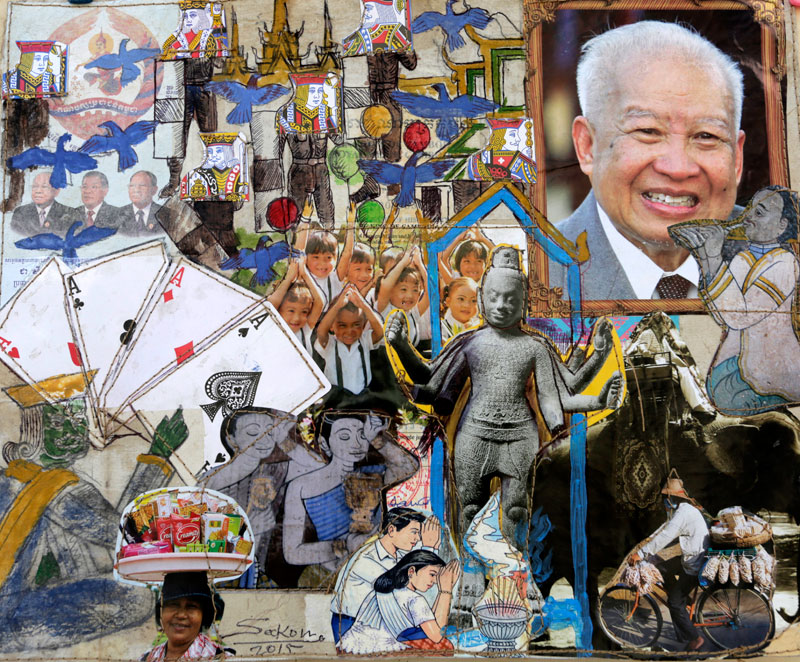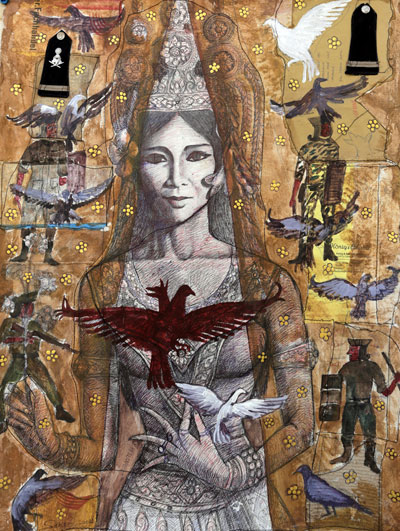Against the backdrop of Cambodians’ age-old beliefs and Buddhist faith, artist Leang Seckon has over the last 15 years depicted issues ranging from city garbage and land grabbing to the emotional scars left by the conflicts of past decades.
His latest series, to be exhibited in the Art Basel Hong Kong show later this month, again features moments that echo Cambodians’ souls and their everyday realities. Yet, there is hidden symbolism for the viewer to interpret and an awareness of the rest of the world that is always present.

Entitled “The King Card Falls on the Road,” it was inspired by the daily bustle around the Chaktomuk Pavilion on the Tonle Sap river, and especially by the playing cards left behind once the players move on.
The series consists of collages incorporating playing cards that Mr. Seckon picked up in the street near the pavilion, which is located across the park from the Royal Palace in Phnom Penh.
“When cyclos and tuk-tuk drivers wait for their guests—foreigners gone to see the Royal Palace—and have time for a nap, drink or playing cards, they often throw the cards away when their guests return,” he said. A cardboard deck, with all 52 cards, can be bought for 1,000 riel, or about $0.25, he said.
The concept for the series was born nearly a year ago as Mr. Seckon, who had just completed his latest series, “Hell on Earth,” was preparing to go to London where it would be featured in a solo exhibition.
“I was not planning anything yet,” Mr. Seckon recalled. “Every afternoon, when I stop working in my studio, I go for a walk along the Royal Palace and the river for relaxation.
“One day, I saw the first card,” he said. It was a king of hearts. A few days later, he came across another one, this time the matching queen, and the following afternoon the king of clubs.

“I thought: Now I have a new project that will have to do with cards, and I want to get the cards from the street.” Just one collage in the series deviates from the idea: for this, he used a set of cards given by a friend.
Created out of the street, so to speak, the series includes several works about life around the Chaktomuk pavilion and on Phnom Penh’s hectic roads.
The collage entitled “In Front of the Royal Palace,” featuring the four aces, is a cheerful scene. A vendor carries a tray of snacks on her head, worshippers pray in front of burning incense and blue birds can be seen flying toward the palace in the background. There are also signs of things past: a photo of the late King Norodom Sihanouk and a sketch of Sambo, Phnom Penh’s last elephant, who retired and left the city in December.
Papered with playing cards set one against the other, the work “Way of Life” depicts the varied means of transportation used by ordinary Cambodians. These range from a minivan with passengers perched on top of wrapped goods piled on the roof and a motorbike rider with dozens of live ducks tied to the back, to a cyclo carrying a street vendor and her equipment.
For the work “Valentine’s Day,” created last month, kings, queens and jacks were cut out of playing cards and displayed in the collage with flowers drawn next to them, as if the characters were holding bouquets. In the middle is a heart-shaped photo of a senior monk pouring water over young monks as part of a purification ritual.
“Being Buddhist,” Mr. Seckon said, “is to be filled with love…. It’s not only sexual love, you know. It’s love that is gentle, cleansing, pure.”

One work in the series does not feature cards, although it also references the Royal Palace and encapsulates the history of the 1960s up to the 1990s.
Featuring “Princess Buppha Devi Dancing Behind a Curtain” as the title indicates, it depicts the princess—a star Khmer classical dancer in the 1960s—surrounded by armed soldiers representing the wars of the 1970s and 1980s, with dark birds progressively making room for white ones, signifying the return of peace. The artist, who was born in 1970, lived through those years.
Mr. Seckon’s exhibition will open on March 14 in the Art Basel Hong Kong’s “Insight” section, said Fabio Rossi of the London art gallery Rossi & Rossi, which represents Mr. Seckon.
“We never showed his work in Hong Kong, where I now have a permanent gallery,” Mr. Rossi said. “And he has been producing an amazing body of works.”



